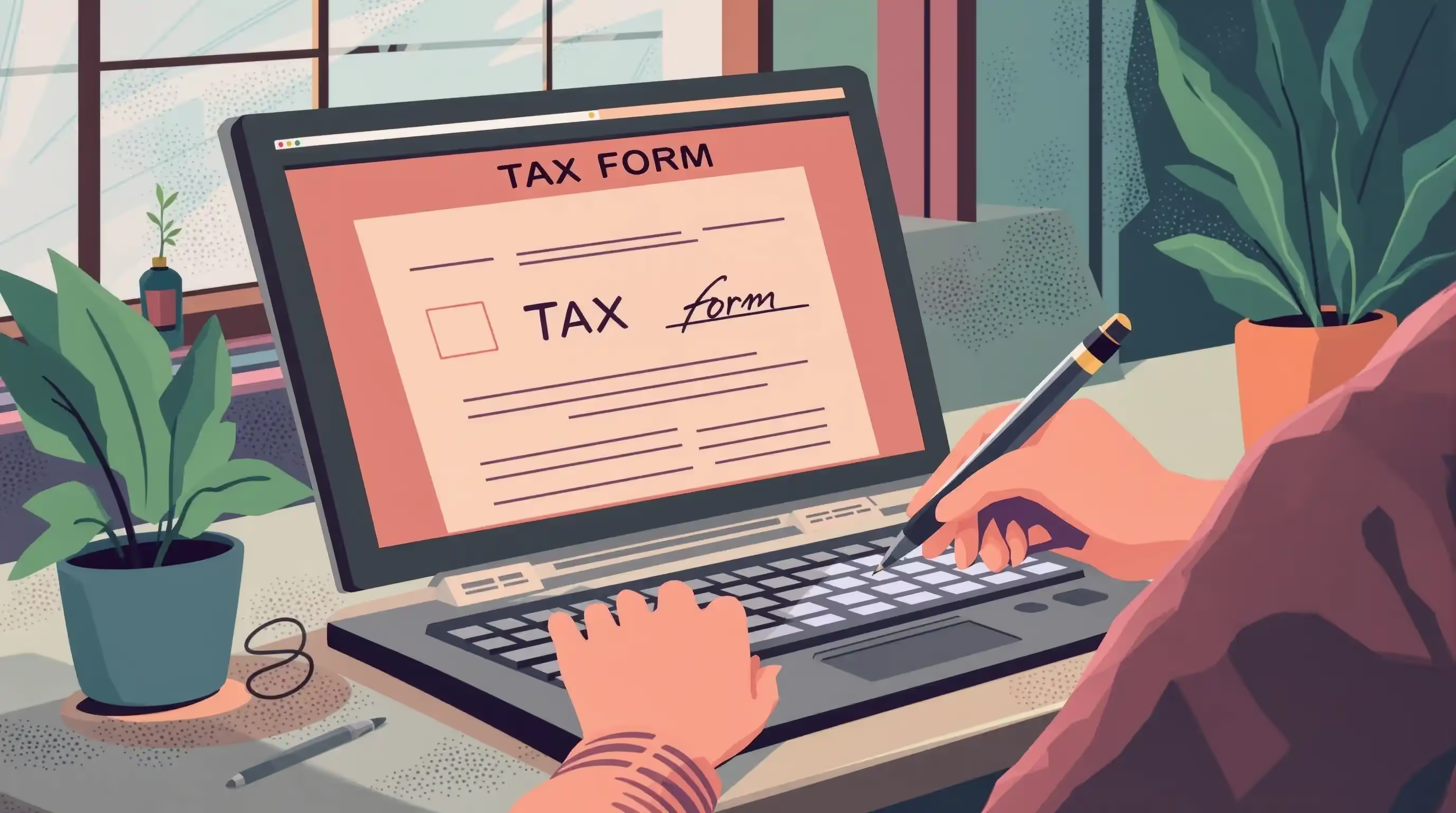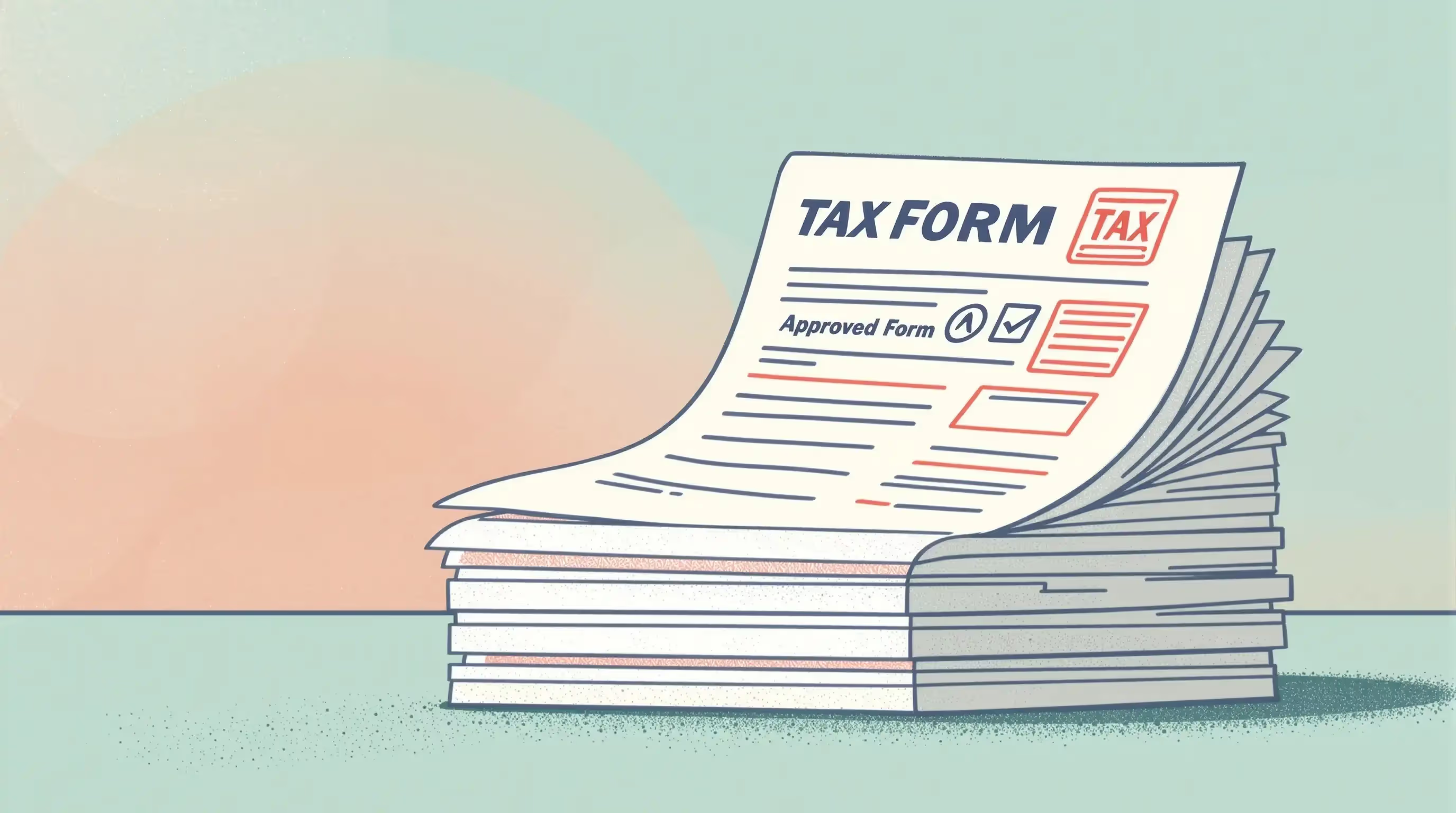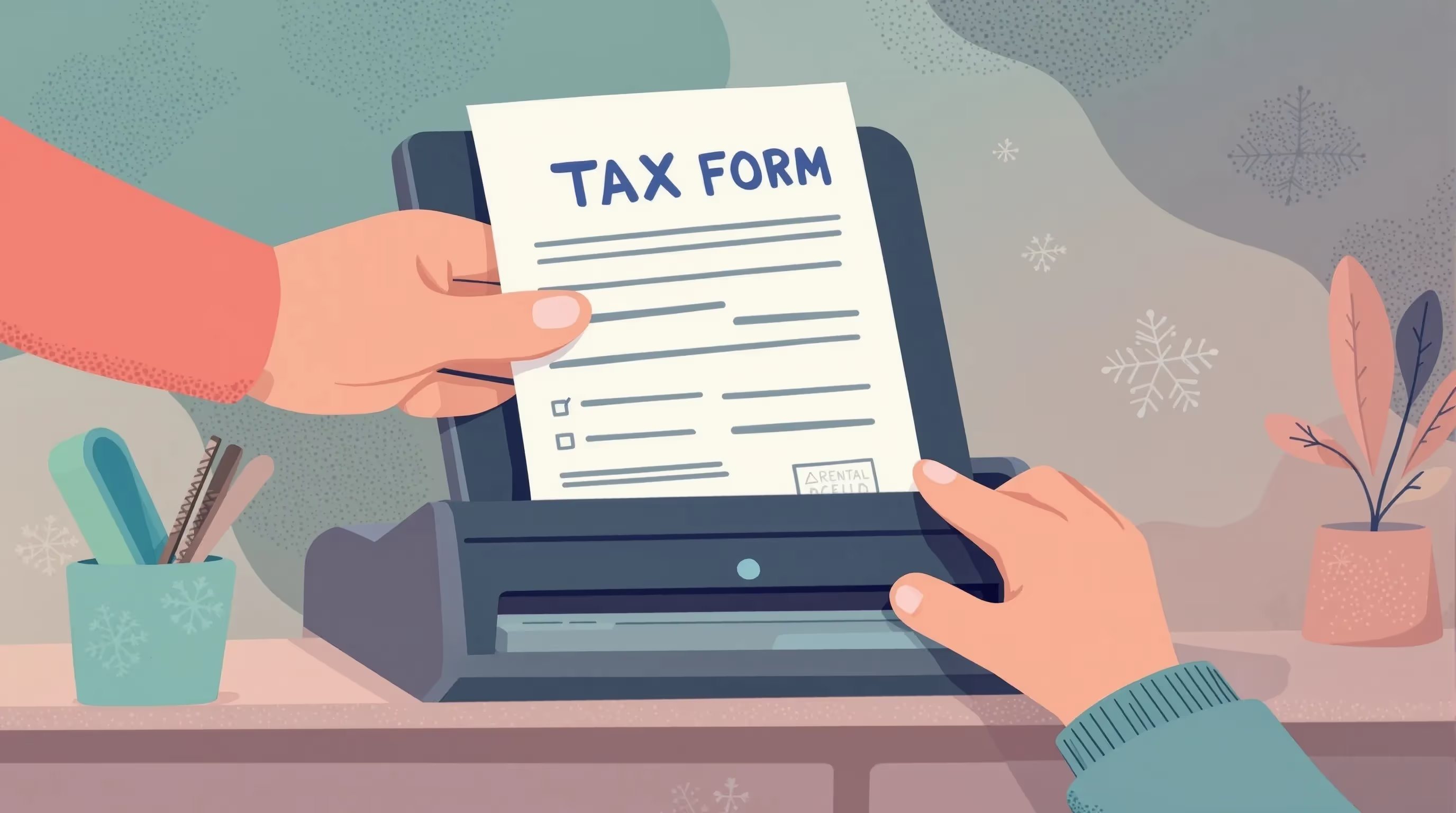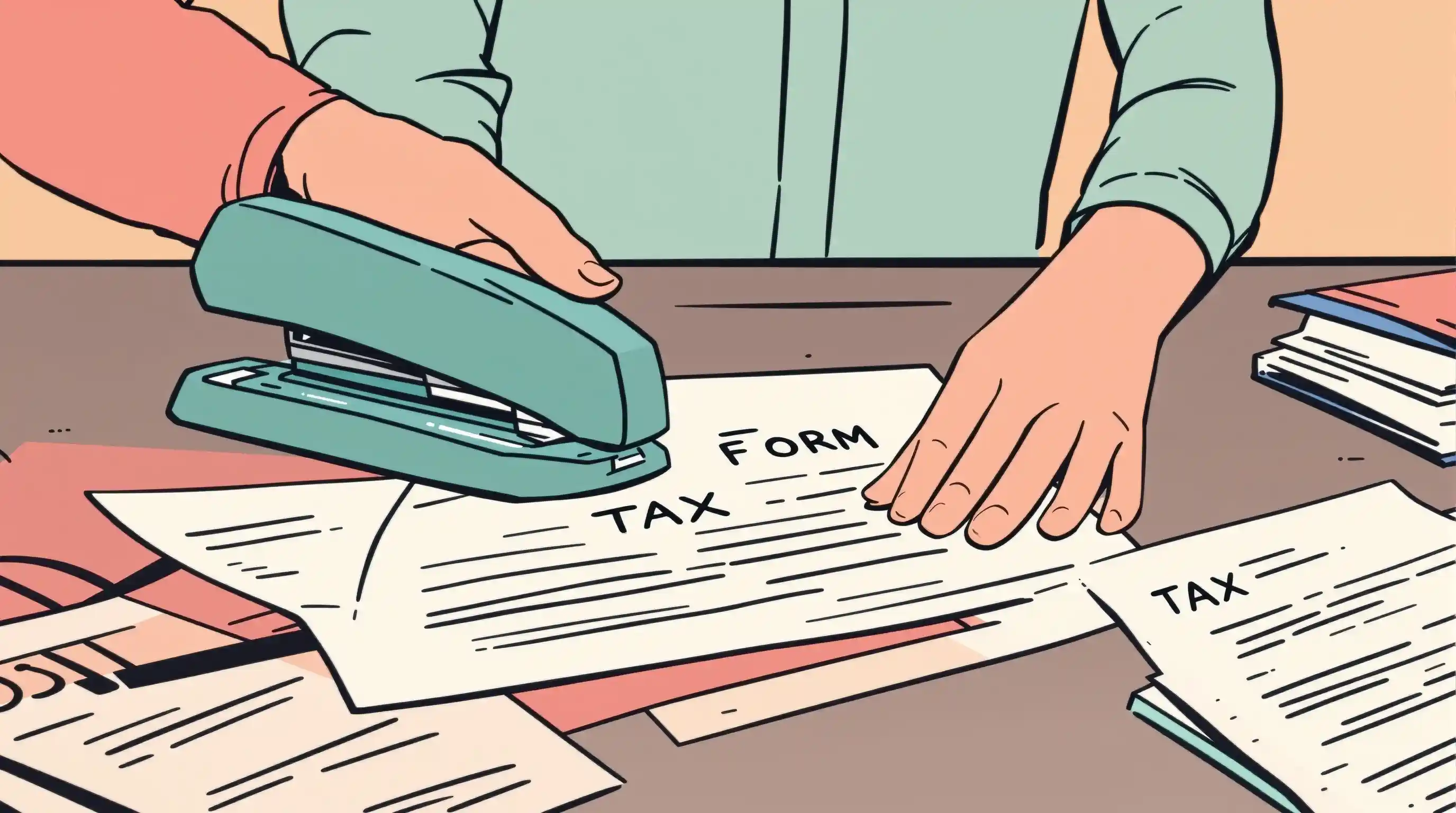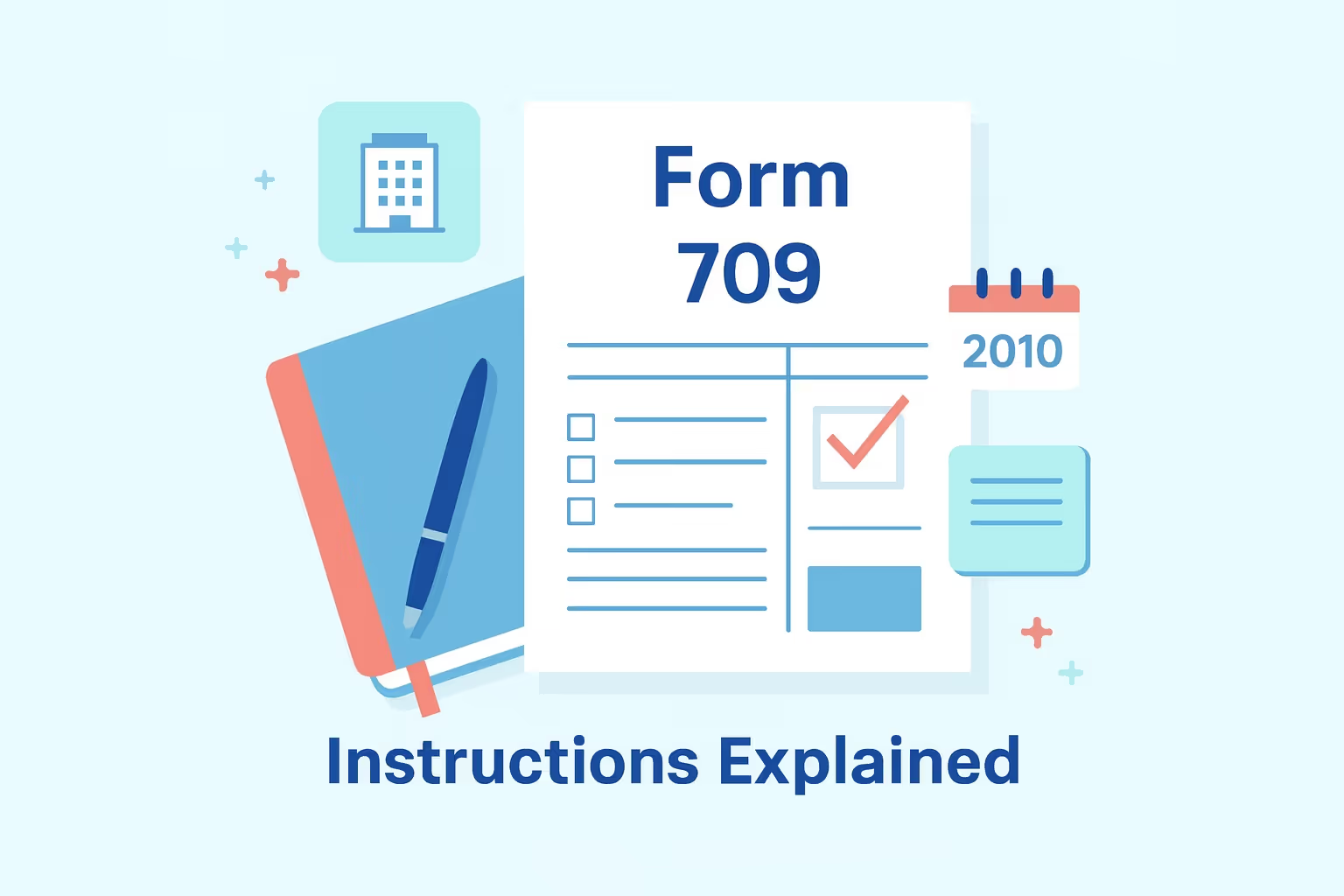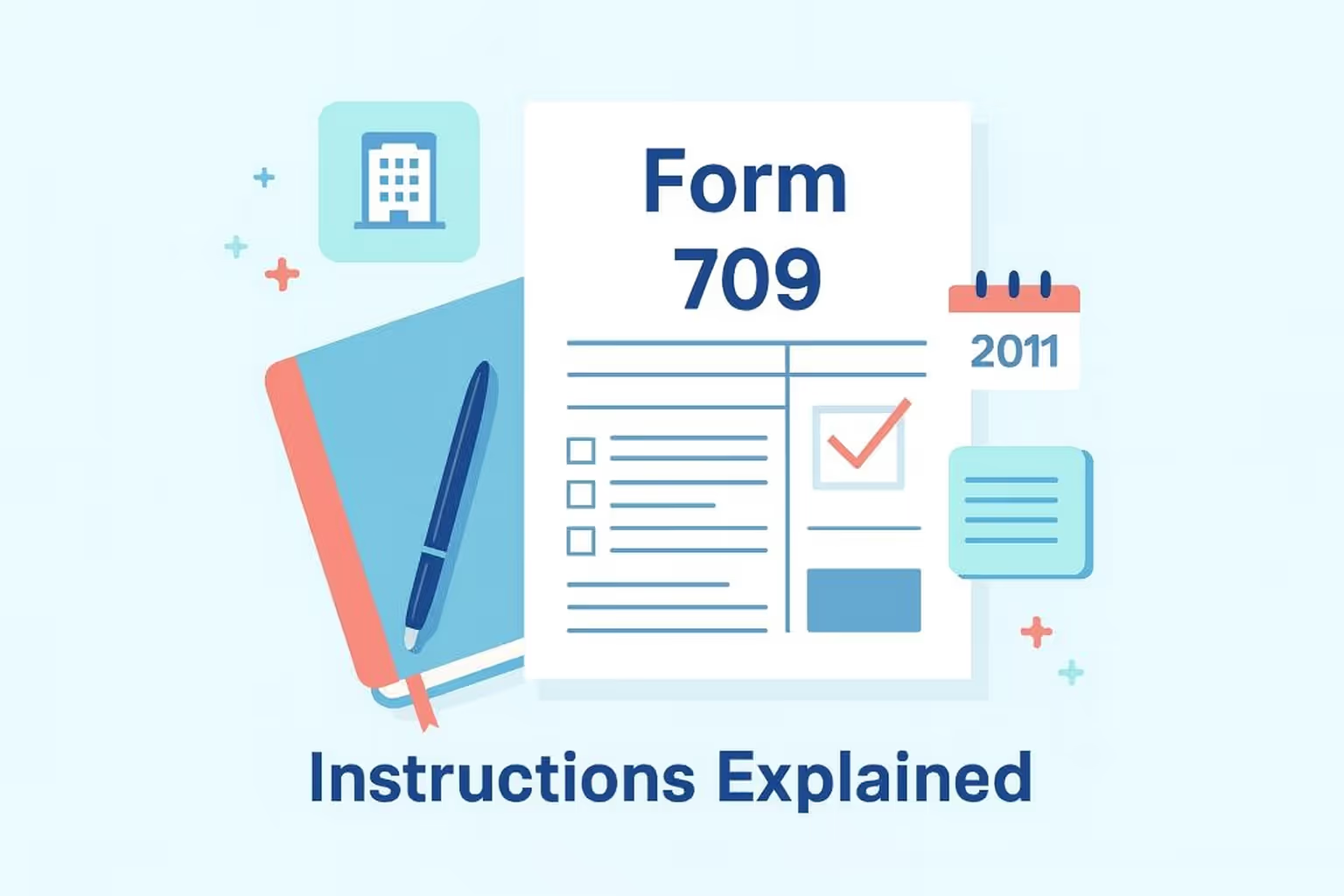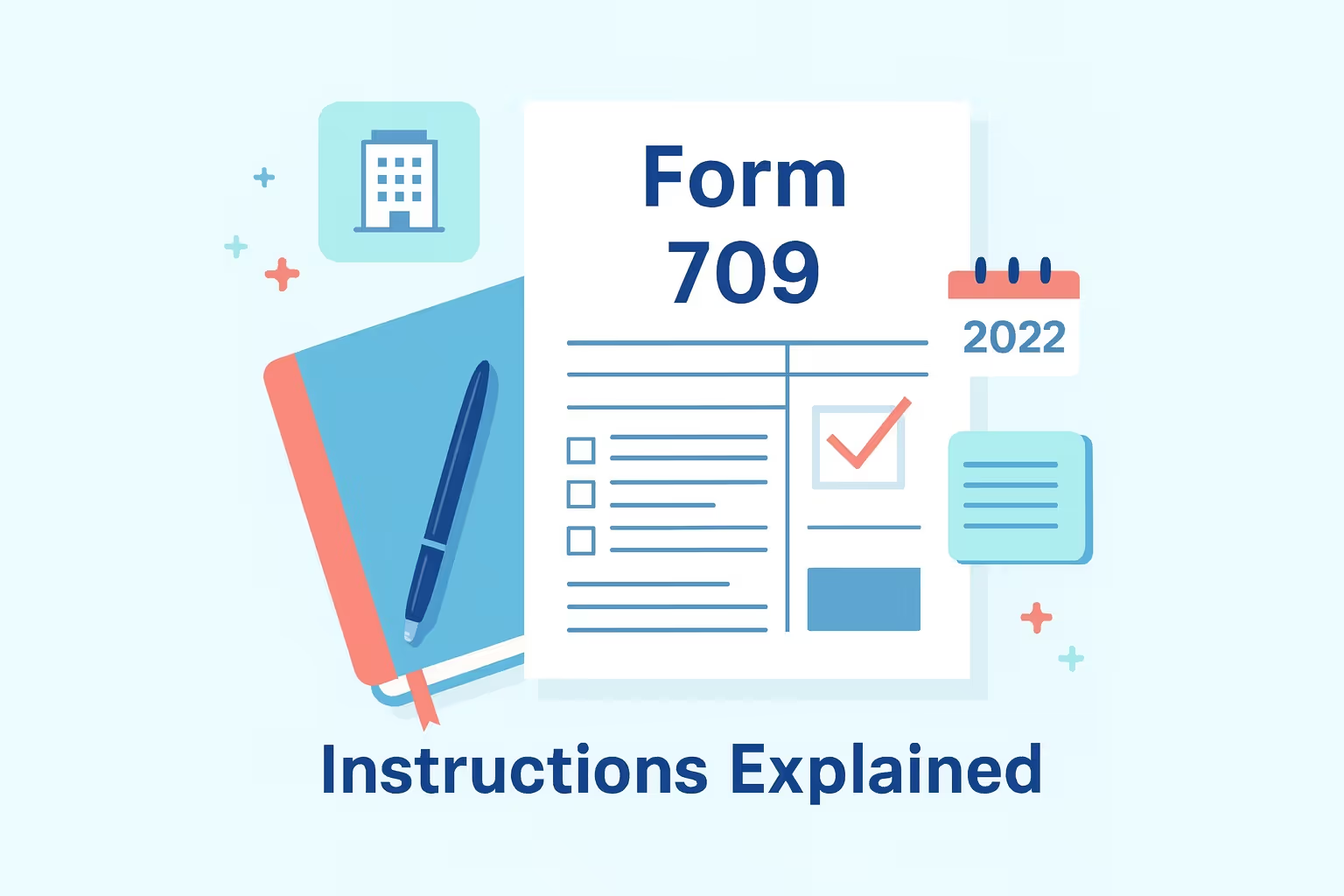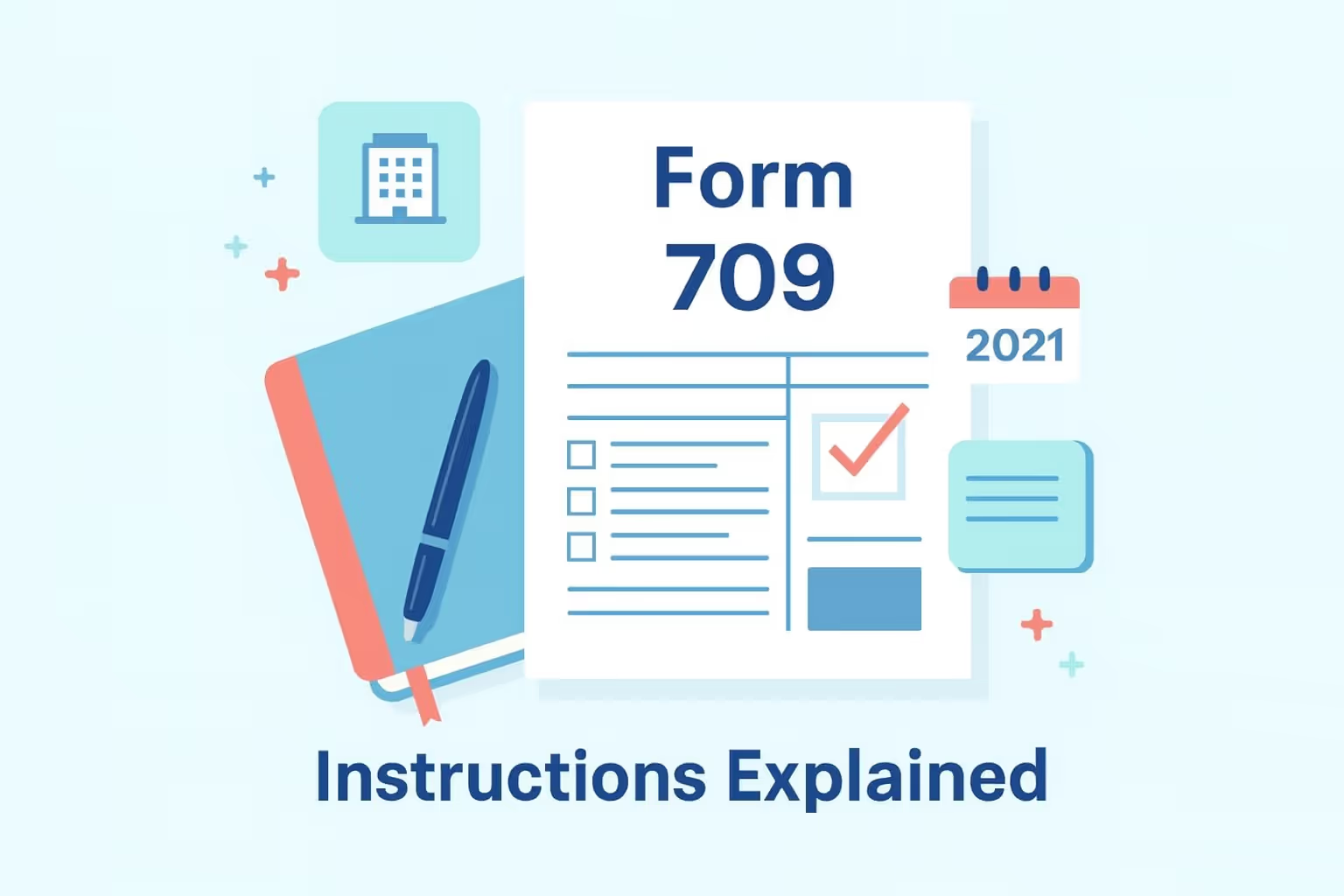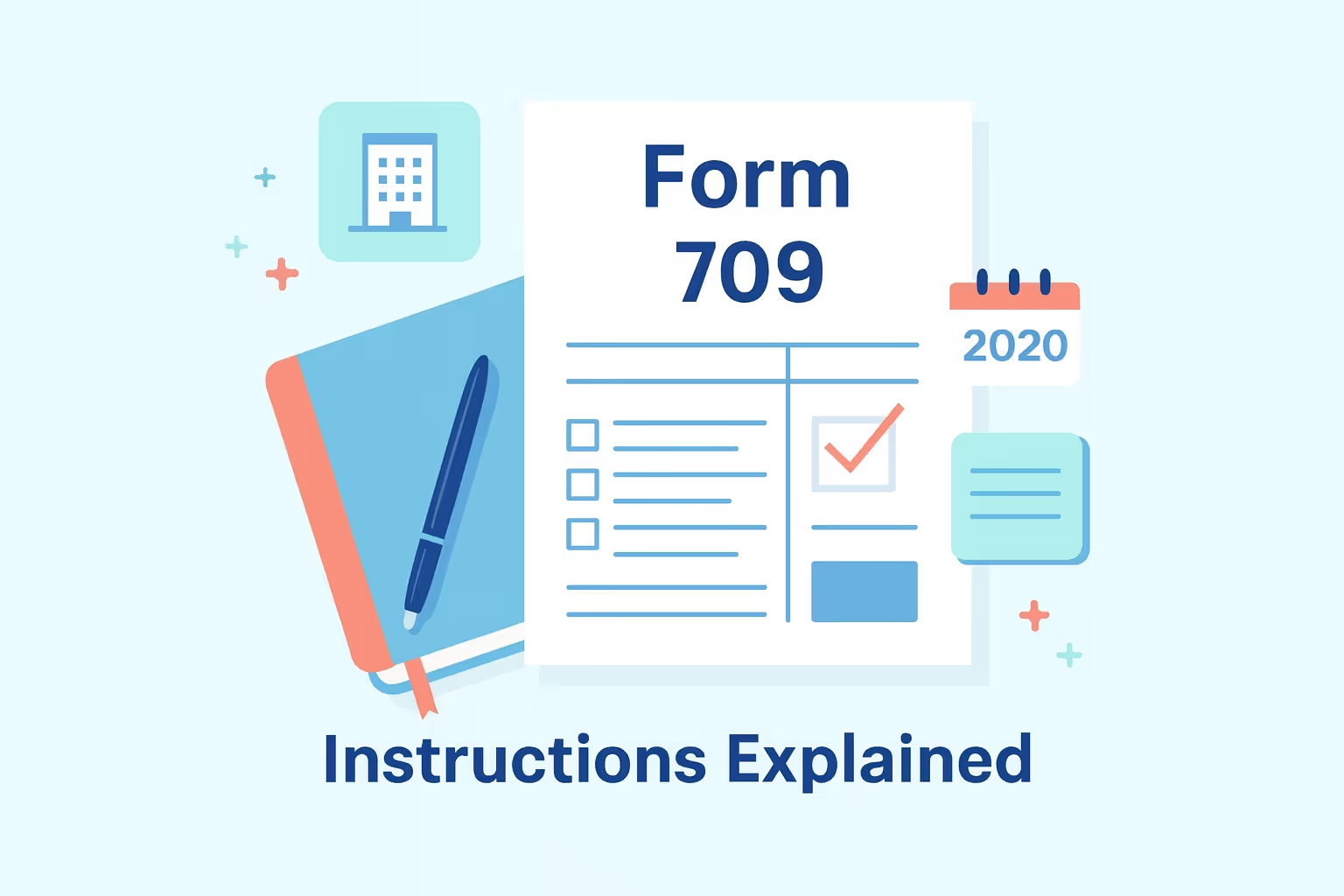Form 709, officially titled the United States Gift (and Generation-Skipping Transfer) Tax Return, is the document the Internal Revenue Service (IRS) requires to report certain gifts and transfers made during the year. It helps taxpayers calculate whether they owe federal gift tax or need to use part of their lifetime gift tax exemption. The form also covers generation-skipping transfers, which apply to gifts made to grandchildren or individuals more than one generation below the donor.
You must file Form 709 if you made taxable gifts during the calendar year 2024 that exceeded the annual gift tax exclusion, gave property of “future interest,” or elected to split gifts with your spouse. Even if no tax is due, filing is essential to record your lifetime exemption and maintain compliance with federal gift tax rules. These filings help the IRS track how much of your estate tax exemption remains available for future use.
For tax year 2024, Form 709 may be e-filed through the IRS Modernized e-File system or mailed to the appropriate address. The filing deadline is April 15, 2025, unless extended for a legal holiday or automatic extension. This guide simplifies the Form 709 2024 instructions into clear, step-by-step explanations so you can accurately prepare your gift tax return, avoid common errors, and comply with IRS requirements.
Understanding Federal Gift Tax and Form 709
Form 709 reports certain gifts made during a calendar year that may be subject to federal gift tax or generation-skipping transfer (GST) tax. The form records taxable gifts, tracks the lifetime exemption for gift tax, and calculates any potential gift tax liability. It also ensures proper documentation for federal estate tax purposes since the gift and estate tax systems share a unified lifetime limit.
This filing is essential for individuals giving significant gifts to family members, transferring business interests, or providing financial support that exceeds the annual gift tax exclusion. Accurate reporting protects donors and recipients from potential IRS issues during future estate reviews.
When Filing Is Required
A Form 709 filing is required if any of the following conditions apply:
- Gifts exceed the annual exclusion amount ($18,000 per recipient for 2024).
- Gifts of future interests are made, such as assets not immediately available to recipients.
- A couple elects to split gifts, combining their exclusions.
- Reportable gifts are made to a non-citizen spouse, trust, or charitable organization that requires documentation.
For complete IRS filing instructions and definitions, refer to the official Instructions for Form 709.
What’s New for Tax Year 2024
The Internal Revenue Service (IRS) has introduced several updates to Form 709 for 2024, reflecting inflation adjustments and procedural changes that affect gift tax returns. These revisions help taxpayers stay current with federal gift tax rules and maintain compliance when filing their United States Gift and Generation-Skipping Transfer Tax Return.
Key IRS Updates for 2024
- Annual Gift Tax Exclusion: For 2024, the annual exclusion amount increased to $18,000 per donee. Gifts under this amount generally do not require filing Form 709 unless classified as future interests.
- Non-Citizen Spouse Exclusion: The exclusion for gifts to non-citizen spouses rose to $185,000, allowing higher tax-free transfers to foreign spouses.
- Lifetime Gift Tax Exemption: The unified lifetime exemption increased to $13.61 million per individual, up from $12.92 million in 2023. This adjustment affects both gift and estate tax planning.
- Digital Assets Question: A new required question on Line 21 asks whether the filer held or transferred digital assets, including cryptocurrency or NFTs.
- Form 709-NA: A new version, Form 709-NA, was created for nonresident non-citizens making gifts of tangible U.S. property.
These updates simplify reporting and clarify how modern assets, like digital holdings, fit within federal gift and GST taxes. Keeping up with annual changes ensures each gift tax return remains accurate and compliant with IRS standards.
Who Needs to File Form 709 (and Who Doesn’t)
Filing Form 709 is required by U.S. citizens or residents when certain gift conditions are met. According to the IRS, a gift tax return must be filed—even if no tax is owed—in these cases:
- Gifts to any person (other than a spouse) exceed the annual exclusion ($18,000 for 2024).
- Gifts consist of future interests, where the recipient cannot immediately enjoy or use the property.
- Gift-splitting with a spouse is elected, allowing shared use of exclusion amounts.
- Gifts are made to a non-citizen spouse, trust, or charitable organization that trigger reporting requirements.
- The donor made generation-skipping transfers (GSTs) subject to separate tax rules.
Each spouse must file a return; joint gift tax returns are prohibited. Notices attached to individual returns must document spousal consent.
Who Does Not Need to File
A Form 709 filing is generally not required when all of the following conditions apply:
- No individual gift exceeded the annual exclusion limit: Each gift stayed within the $18,000 annual limit for 2024, which means no taxable gift amount needs to be reported.
- All gifts qualified as present interest gifts: The recipients had immediate rights to use, possess, or enjoy the property or funds transferred.
- All gifts were made to a U.S. citizen spouse or qualified charity: Each transfer involved the donor’s full interest in the property, leaving no retained ownership or partial interest.
- No special transfers were made: This includes gifts of future interests or other transfers requiring special reporting.
For a detailed explanation of filing requirements and exemptions, visit the official IRS guidance at About Form 709.
Step-by-Step Instructions for Completing Form 709
Filing Form 709 (United States Gift and Generation-Skipping Transfer Tax Return) requires careful documentation and accurate reporting. The steps below outline how to prepare, complete, and review the form to ensure the gift tax return is correct and fully compliant with IRS gift tax requirements.
Preparation Before Filing
Before starting Form 709, gather all necessary financial and supporting records. These may include:
- Gift documentation: Collect copies of checks, appraisals, or transfer statements showing the fair market value of each gift on the date it was made.
- Prior year tax returns: Review previous filings to verify prior exclusions and lifetime exemption amounts already claimed.
- Spousal agreements: If electing gift splitting, prepare a signed consent statement for both spouses to attach to their separate returns.
- Trust or charity records: Maintain evidence of donations, trust agreements, or qualified charitable transfers to document eligibility for exclusions or deductions.
Completing the Form
Each section of Form 709 (2024) calculates explicitly taxable gifts and available exemptions. Complete each part carefully and in the order listed below:
- Part I – General Information: Enter the donor’s address, taxpayer identification number, and filing status. Be sure to answer all questions, including the digital assets question on Line 21, even if no cryptocurrency or NFTs were transferred.
- Part II – Tax Computation: Record the total value of taxable gifts, apply the annual gift tax exclusion, and calculate the gift tax liability using the IRS tax rate schedule.
- Part III – Spouse’s Consent: If electing to split gifts, have the consenting spouse sign this section or attach a separate consent notice.
- Schedule A – Computation of Taxable Gifts: List all gifts made during the year, categorized by part:
- Part 1 – Regular gifts subject only to gift tax
- Part 2 – Direct skips subject to both gift and GST taxes
- Part 3 – Indirect skips and other transfers in trust
- Part 4 – Reconciliation of total taxable gifts
- Part 1 – Regular gifts subject only to gift tax
- Schedules B, C, and D:
- Schedule B records gifts made in prior years to calculate cumulative totals.
- Schedule C reports the deceased spousal unused exclusion (DSUE), if applicable.
- Schedule D computes any generation-skipping transfer tax owed.
- Schedule B records gifts made in prior years to calculate cumulative totals.
- Signature and Verification: Before submission, sign and date the return, ensuring all attachments, appraisals, and supporting documents are included.
Review and Common Filing Tips
- Verify that all values, dates, and recipient information match supporting documentation.
- Confirm that annual exclusion amounts and lifetime gift tax exemption totals are accurate.
- Attach all required schedules and consent forms before filing.
- Keep a copy of the filed return and all supporting materials for personal and estate tax records.
Completing Form 709 carefully helps prevent IRS processing delays and ensures accurate tracking of lifetime and annual exclusions for future gift tax returns.
Filing Methods: Electronic and Paper Options
The Internal Revenue Service (IRS) allows taxpayers to submit Form 709 (United States Gift and Generation-Skipping Transfer Tax Return) electronically or by mail. The correct method depends on filing preferences, software access, and comfort level with electronic systems.
Electronic Filing (e-File)
Beginning with tax year 2024, the IRS accepts Form 709 2024 instructions through the Modernized e-File (MeF) system. This digital filing method offers faster processing, secure transmission, and immediate confirmation once the return is accepted.
- Convenient and Paperless: The e-File process eliminates the need for physical documents, reducing mailing time and errors.
- Faster Processing: Electronically submitted returns are typically acknowledged within hours instead of weeks.
- Secure Access: Only authorized users or preparers can transmit a return through the IRS MeF system.
- Automated Calculations: Most approved preparation programs perform built-in checks to prevent common mistakes.
- Authorized Filing Options:
- Appoint a qualified tax preparer or reporting agent to e-file on the donor’s behalf.
- Register as an authorized e-file provider through the IRS application portal.
- Appoint a qualified tax preparer or reporting agent to e-file on the donor’s behalf.
To ensure compatibility, keep the latest version of Adobe Acrobat Reader for PDF attachments used within the system.
Paper Filing
Taxpayers who prefer traditional filing may still submit Form 709 by mail. Completed returns should be sent to the address specified in the official IRS instructions, which vary by state of residence. The filing deadline for 2024 gifts is April 15, 2025, unless extended due to a legal holiday or approved extension request. When mailing, include all schedules, supporting documents, and payments due. Always retain proof of mailing and a full copy of the federal gift tax return for personal records.
How to Pay Gift Tax
After completing Form 709 (United States Gift and Generation-Skipping Transfer Tax Return), any gift tax liability must be paid by the filing deadline. For tax year 2024, payments are due April 15, 2025, unless granted an extension. Even if no tax is owed, it is essential to file the return to track how much of the lifetime gift tax exemption and estate tax exemption has been used.
When Payment Is Required
A payment is due only when the taxable gifts made during the year exceed the available annual gift tax exclusion and any remaining lifetime exemption. The Internal Revenue Service (IRS) uses the total value of reportable gifts to calculate the final balance owed. If the federal gift tax exceeds available credits, payment must be made in full by the due date to avoid interest and penalties.
Accepted Payment Methods
- Electronic Federal Tax Payment System (EFTPS): Individuals and authorized representatives can make secure online payments.
- IRS Direct Pay: Allows payments directly from a checking or savings account without additional fees.
- Check or Money Order: Payments should be made payable to the United States Treasury and include the taxpayer’s name, Social Security number, and “Form 709, Tax Year 2024.”
- Payment Voucher: If mailing a payment, include the appropriate voucher form to ensure accurate processing.
Timely payment ensures accurate application of credits and prevents unnecessary gift tax penalties or interest charges.
Understanding Schedules A–D and Required Attachments
Each schedule within Form 709 (United States Gift and Generation-Skipping Transfer Tax Return) serves a specific role in reporting taxable gifts, exclusions, and transfers that may trigger gift and GST taxes. Completing these schedules accurately ensures the return correctly reflects all reportable gifts and exemptions claimed for tax year 2024.
Schedule A – Computation of Taxable Gifts
This schedule lists every gift made during the year and organizes them by category:
- Part 1 – Regular Gifts: Reports gifts subject only to the federal gift tax.
- Part 2—Direct Skips: Records transfers made directly to skip persons, such as grandchildren, are also subject to the generation-skipping transfer tax.
- Part 3 – Indirect Skips: Covers transfers to trusts or other entities where a skip may occur later.
- Part 4 – Reconciliation: Calculates the total taxable gifts after allowable deductions.
Schedule B – Gifts From Prior Periods
This schedule compiles gifts reported in prior years to determine the cumulative total of lifetime gifts. The running total is used in the tax computation to ensure proper lifetime gift tax exemption application.
Schedule C – Deceased Spousal Unused Exclusion (DSUE)
This section allows the filer to claim the deceased spousal unused exclusion, transferring any remaining lifetime exemption from a late spouse. Supporting documents must be attached, such as the first four pages of the deceased spouse’s estate tax return (Form 706).
Schedule D – Computation of Generation-Skipping Transfer Tax
This schedule calculates any GST tax liability. It covers direct and indirect skips, reconciles GST exemption allocations, and computes any tax due. Completing all schedules accurately and including the required supporting statements and appraisals helps the Internal Revenue Service (IRS) process the federal gift tax return efficiently and without unnecessary delays or adjustments.
Common Errors and How to Avoid Them
The Internal Revenue Service (IRS) frequently delays or rejects Form 709 (United States Gift and Generation-Skipping Transfer Tax Return) because of small but preventable mistakes. Awareness of these common errors helps taxpayers file gift tax returns accurately and on time.
Frequent Filing Errors
- Leaving required questions unanswered: Every filer must answer all sections, including the question about digital assets on Line 21, even if no cryptocurrency or NFTs were transferred.
- Using the wrong form type: Nonresident individuals who are not U.S. citizens should use Form 709-NA, not the standard Form 709.
- Incorrectly reporting gift-splitting: When a married couple elects to split gifts, each spouse must submit a separate return and include a signed consent statement confirming the election.
- Misapplying exclusions: Gifts called future interests, such as trust contributions without withdrawal rights, do not qualify for the annual exclusion.
- Incomplete or missing documentation: Omitted Schedules A–D, appraisals, or attachments often delay IRS correspondence or processing.
- Missing deadlines: Returns filed after the extended due date can lead to penalties unless an automatically extended election was made through a timely filed extension request.
Tips for Avoiding Mistakes
- Review all entries before signing the return.
- Confirm that taxable gifts and lifetime exemption figures align with prior returns.
- Keep organized records and copies for estate tax purposes.
Careful review helps avoid unnecessary notices, delays, or penalties, ensuring the gift tax return is processed smoothly and accurately.
Exceptional Guidance for Zero-Activity Years
Some gift givers may have a year without any new reportable gifts. Even in these cases, filing Form 709 (United States Gift and Generation-Skipping Transfer Tax Return) may still be necessary to maintain accurate records for gift and GST taxes and to protect essential exemption elections connected to lifetime estate planning.
When a Filing May Still Be Needed
- Generation-Skipping Transfer (GST) Elections: Filing may be needed to make or revoke a GST exemption allocation that affects future gift recipients.
- Corrections to Prior Returns: A filing can be used to correct earlier mistakes or update elections that impact how the gift tax applies to previous transfers.
- Protective Elections: Some filers submit a “protective” return to safeguard eligibility for specific tax benefits related to estate and gift tax rules.
Recordkeeping During Inactive Years
Accurate recordkeeping remains essential, even when no gifts occur. Taxpayers should:
- Keep prior individual income tax return records alongside gift tax filings for reference.
- Track remaining exemption balances to prevent exceeding limits when future transfers are reported.
- Retain documentation for medical expenses, tuition payments, or other gifts of interest, gifts excluded from tax.
Organized files simplify future reporting and ensure the Internal Revenue Service (IRS) can verify past transactions when taxpayers pay taxes or amend prior filings.
First-Time Filer Tips
Filing Form 709 (United States Gift and Generation-Skipping Transfer Tax Return) for the first time can seem challenging, especially for those unfamiliar with federal income tax or gift tax purposes. The following guidance helps new filers stay accurate, compliant, and confident.
Before You Start
- Gather supporting documents: Collect receipts, appraisals, and statements showing the fair market value of every gift on the transfer date.
- Review prior returns: Compare previous filings to confirm prior exclusions or lifetime exemptions before preparing the new income tax return and Form 709.
- Understand gift classifications: Gifts of present interests qualify for the annual gift tax limit, while future interests or only a partial interest in property must be reported.
- Know which transfers are excluded: Certain tax-free gifts, such as tuition or medical payments made directly to institutions, are exempt from reporting.
- Seek professional advice: A qualified preparer can help calculate the correct gift tax rate and determine when to file a return.
Filing Confidence for First-Time Filers
Careful organization prevents delays and IRS corrections. Always verify all amounts, attach required schedules, and follow current Form 709 instructions for 2024. Proper preparation ensures compliance, accurate reporting, and effective tracking of lifetime exemptions tied to both gift and estate tax planning.
Frequently Asked Questions (FAQs)
How does the annual gift tax exclusion affect my 2024 filing?
The annual gift tax exclusion allows each individual to give up to $18,000 per recipient in 2024 without owing tax or reducing their lifetime gift tax exemption. Only gifts exceeding this limit must be reported on Form 709. However, even if no tax is due, filing ensures proper recordkeeping of lifetime exemption usage for gift and estate tax planning.
What qualifies under the federal gift tax exclusion?
The gift tax exclusion covers most direct monetary or property gifts made during the year, provided they are present interest gifts—meaning recipients can use the assets immediately. Gifts exceeding the annual limit, or those involving future interests, must be reported. Certain transfers, such as tuition or medical payments made directly to institutions, may also qualify for unlimited exclusions under gift tax rules.
How is Form 709 connected to the federal estate tax?
The estate and gift tax share a unified lifetime exemption, currently $13.61 million for 2024. Gifts reported on Form 709 reduce the remaining exemption available at death. Accurate tracking helps prevent overuse of credits and ensures a smooth transition of assets under federal estate and gift tax law. Both taxes are administered by the Internal Revenue Service (IRS).
What is the 2024 gift tax limit, and how is it applied?
The gift tax limit refers to the annual $18,000 exclusion per donee and the lifetime exemption of $13.61 million per individual. Any taxable gifts exceeding these limits require reporting on Form 709. Understanding these thresholds helps donors plan long-term giving strategies without exceeding the cumulative federal gift tax and estate tax exemptions.
How do gift and GST taxes work together?
Gift and GST taxes apply when assets are transferred to recipients younger than one generation, such as grandchildren, who are more than one generation younger than the donor. The generation-skipping transfer tax works alongside the gift tax to prevent avoiding taxation through multigenerational transfers. Both are reported using Form 709, with specific sections dedicated to gift and generation-skipping transfers.







